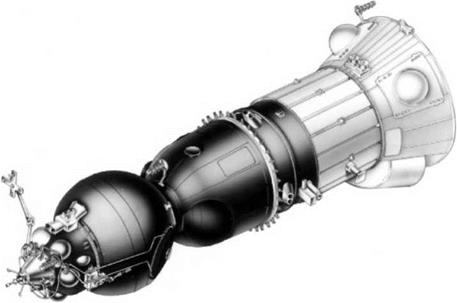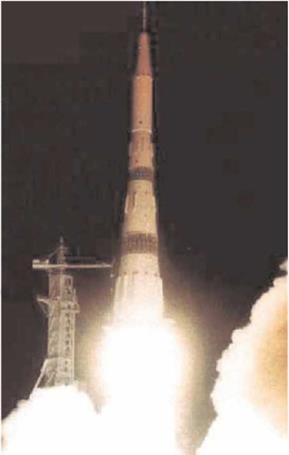THE N-l LUNAR MISSION SERIES: 1969-1972
Campaign objectives:
Apollo 8 subjected the Soviets to the same anxiety felt by the Americans after the successes of the USSR in earlier years. A re-evaluation of Soviet plans resulted in a new resolution on January 8. 1969. The human circumlunar program would continue despite the clear recognition that relative to Apollo 8 it would appear both late and inferior to the world. Also, the human landing program would proceed even though it was evident that if they were not delayed by serious problems the Americans were likely to be first. Once the lunar programs were accomplished, the Americans would be upstaged in the late 1970s by using the N-l for Korolev’s originally envisioned destination, Mars. The space station program and robotic flights to the Moon, Mars and Venus were to be accelerated and represented in the press as the main thrust of the Soviet program.
The N-l rocket, the Soviet counterpart of the Saturn V, w;as a key element in this strategy since it w ould launch the spacecraft that w ould see cosmonauts land on the Moon. N-l development began in 1962 and the first launch was initially expected in 1965, but there were major delays due to organizational infighting, budgetary issues, and a total redesign of the vehicle in 1964. In particular, engine development was a key technological and organizational factor. As a result, development of the N-l fell behind relative to the Saturn V.
In early 1969 the N-l w as deemed ready for testing, hurried by the advance of the American manned lunar landing program. These launches carried orbital versions



![]()
7K-L1S No.3S
Lunar Orbit and Return Test Flight USSR TsKBEM ^
N-1-3L
February 21, 1969 at 09:18:07 UT (Baikonur) First stage failed in llight.
7K-L1S No. SL
Lunar Orbit and Return Test Flight USSR, TsKBEM "
N-1-5L
July 3, 1969 at 20:18:32 UT (Baikonur) First stage exploded at liftoff.
7K-LOK No.6A
Lunar Orbit and Return Test Flight
USSR TsKBEM
N-1-7L
November 23, 1972 at 06:11:55 UT (Baikonur) First stage exploded in flight.
of the circumlunar Zond spacecraft. All the launch tests failed, in every case due to problems in the first stage. The first test was in February and the second in July, just as the US was preparing to launch Apollo 11. Although the race to Moon was nowr lost, the Soviets, still hoping one day to land cosmonauts on the surface, persisted in their automated testing of the cireumlunar spacecraft with back to back successes by Zond 7 and 8 in August 1969 and October 1970 respectively. Another N-l test failed in June 1971. as did the fourth in November 1972, a month before the final Apollo lunar landing. At this point the N-l was abandoned, ignominiously ending the Soviet manned lunar program.
Spacecraft:
The 7K-LOK lunar orbital Soyuz differed significantly from the circumlunar Zond. It had a wider skirt on the service module, which now had two engines. One was the standard Soyuz engine, which on an operational mission would perform lunar orbital rendezvous. The new engine was larger, and was to boost the LOK out of lunar orbit and back to Earth. An orbital module was included just like the Earth – orbital Soyuz, but it differed in some ways. It had more ports for lunar observation and an attitude control system and docking system on the front for rendezvous and docking with the returning lunar lander. It also had a large hatch. In contrast to Apollo, the cosmonaut was to transfer between the orbital module and the lunar
|
Figure 11.15 The Soyuz 7K-LOK lunar orbiler (courtesy Energiya Corp). |
lander by spacewalking. As the 7K-LOK was the first Soviet spacecraft to have fuel cells for electrical power, it did not need solar panels.
On an operational mission the lunar orbital Soyuz would be carried above the LK lander, which would be on the Block D propulsion system, here serving as the fifth stage of the N-l. This whole stack would be accelerated out of parking orbit towards the Moon by the fourth stage, which would then be discarded. The Block D was to perform midcourse maneuvers, lunar orbit insertion, and preliminary maneuvers in orbit, before flying the lunar lander down to an altitude of about 1,500 meters, where it would be released and the lander would ignite its own engine for the final phase of the descent. This was quite different from the Apollo system.
The payloads for the first two N-l test launches were the Block D. a dummy LK and instead of the 7K-LOK, which was not ready, a 7K-L1S Zond cireumlunar test spacecraft fitted with an attitude control block for operations in lunar orbit. The plan was for these missions to insert the modified Zond into lunar orbit and then return it to Earth. However, as noted, both launches failed. The third N-l was basically just a test of the launcher itself, and it carried only spacecraft mockups. However, for the fourth test it was decided to launch a complete 7K-LOK lunar Soyuz and a dummy LK lunar lander. The plan called for spending 3.7 days in lunar orbit, during which the spacecraft would image future landing sites before returning to Earth.
N-l test launches:
N-l no. l: 7K-L1S No.3S circumlunar vehicle and dummy LK lunar lander.
N-l no.2: 7K-L1S No.5L circumlunar vehicle and dummy LK lunar lander.
N-l no.3: Mockup LOK and LK spacecraft.
N-l no.4: 7K-LOK No.6A lunar Soyuz and dummy LK lunar lander.
7K-L1S launch mass: 6,900 kg
7IC-LOK launch mass: 9,500 kg
Mission description:
The first test of the N-l failed on February 21. 1969. Two of the thirty engines in the new first stage booster shut down just before liftoff, but the rocket was designed to handle this situation by burning the remaining engines for longer. At 5 seconds a gas pressure line broke and at 23 seconds an oxidizer line broke, resulting in a fire in the array of engine noz/lcs that burned through engine control system cables and caused the booster to shut down at the 70 second mark. The automatic escape system drew the Zond clear and the capsule landed safely 35 km from the launch site. The debris from the exploding vehicle fell 50 km away. The blast shattered windows across a wide area, including those in assembly buildings and a local hotel.
The second N-l test failed spectacularly on July 3, 1969, just thirteen days before the launch of Apollo 11. After ignition, the massive rocket rose to a height of about 200 meters and then fell back onto the pad in a huge explosion that totally destroyed the pad and severely damage buildings across a wide area. A US spy satellite caught an image of the aftermath. At the 0.25 second mark the oxidizer pump in one of the first stage engines had been damaged by ingesting a foreign object through its feed lines and it exploded. The resulting fire quickly engulfed the engine compartment of the booster. At the 10 second mark the control system shut dowm most of the engines and the vehicle fell and exploded. The 7K-L1S escape system worked perfectly and the capsule was recovered 2 km away. This disaster banished the hope of using this rocket to compete with the Americans as they prepared for their first manned lunar landing.
N-l launches did not resume until long after the race to the Moon was settled. The third test failed on June 28, 1971. Booster roll control was lost 48 seconds into the flight and the vehicle broke up. The fourth and final test failed on November 23. 1972, when the first stage exploded at 107 seconds into the flight, just a few seconds before it was to have shut down and handed over to the second stage. Ironically, the cause may have been excessive shock to the engine array arising from the sequenced shutdown of the central engines. Any remaining hopes the Soviets had for sending cosmonauts to the Moon were lost in this final failure.
|
Figure 11.16 Third N-l launch attempt just before clearing the tower. |
Results:
Коле.












